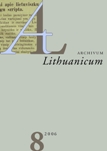Aštuntasis Ehrenreicho Weismanno Lexicon bipartitum leidimas (1725) – Pilypo Ruigio žodyno (1747) vokiečių– lietuvių kalbų dalies registro šaltinis
The eighth edition of Lexicon Bipartitum by Ehrenreich Weismann (1725) as a source for the German-Lithuanian part of the dictionary by Pilypas Ruigys (1747)
Author(s): Vilma ZubaitienëSubject(s): Theoretical Linguistics, Lexis, Historical Linguistics, Baltic Languages, 18th Century
Published by: Lietuvių Kalbos Institutas
Keywords: Lexicon Bipartitum; Ehrenreich Weismann; 18th century; Pilypas Ruigys; German-Lithuanian;
Summary/Abstract: In the foreword to the dictionary, Ruigys himself mentioned only the name of the author of the source, indicating neither the exact title nor the year of the publication. In the Lithuanian bibliography it is thought that Ruigys used the 1741 dictionary by Weismann. In his recent study Vincentas Drotvinas claims that Ruigys could have referred to the 1725 dictionary or one of the earlier editions by Weismann. The article explores the history of the editions of the Lexicon bipartitum by the German lexicographer and educator Ehrenreich Weisman (abbr. germ. Erich, lat. Eryc), presents some facts from the biography and activities of the author. In order to find out which editions of the dictionary by Weismann Ruigys could have used, all the editions are described and their chronological sequence is provided. The first edition is a Latin‑German dictionary, thus it could not have been the source for the German‑Lithuanian part of the dictionary by Ruigys. Starting with the second edition, the dictionary has a German‑Latin part. It is possible to distinguish three periods in editing the dictionary by Weismann: the early (WL and WŽ2), the middle (WŽ3–WŽ6) and the late (WŽ7). WŽ8–WŽ10 editions were published posthumously. WŽ8 is an edited version of WŽ7, done by some other person(s). WŽ9 and WŽ10 do not differ from WŽ8 in the number of pages. A more detailed analysis of the foreword and preface to the dictionary is provided with the aim of discussing the purpose, sources and type of lexis of the dictionary. The main sources were earlier German dictionaries and works by Roman authors. The second German‑Latin part was updated with terms relevant in those days. The article also presents a comparative analysis of the German‑Latin editions (WŽvl2 [1685] WŽvl3 [1692], WŽvl7 [1715], WŽvl8 [1725], WŽvl9 [1732], WŽvl10 [1741]) of the Lexicon bipartitum by Ehrenreich Weismann and the German‑Lithuanian part (RŽvl) of the dictionary by Pilypas Ruigys.
Journal: Archivum Lithuanicum
- Issue Year: 2006
- Issue No: 08
- Page Range: 97-148
- Page Count: 52
- Language: Lithuanian

